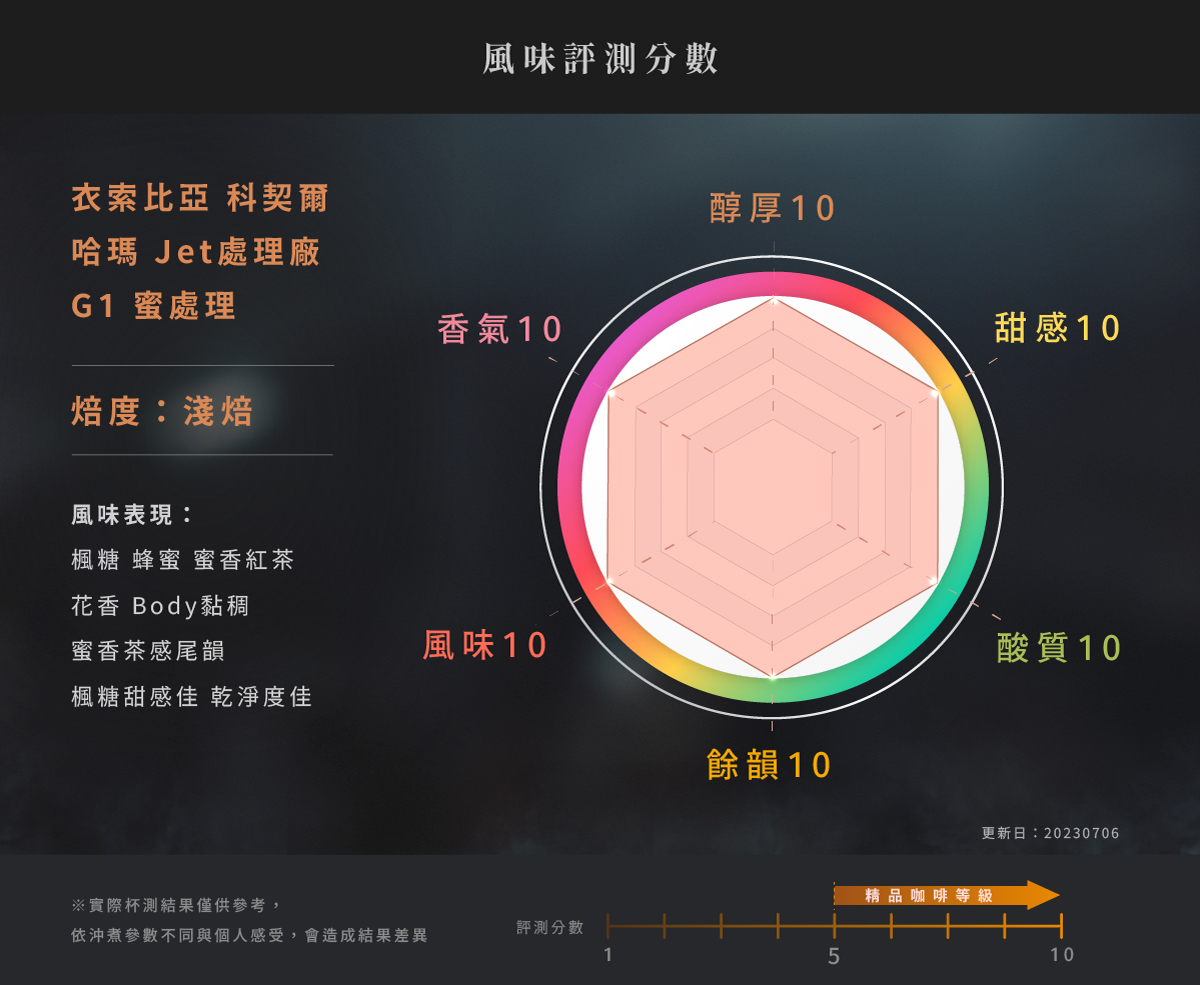

Ethiopia Kochere Hama Jet Washing Station G1 Honey









Coffee Flavor
The flavors of coffee are derived from the breakdown of various nutrients in the green coffee beans during roasting. Heat causes these compounds to degrade into a variety of aromatic molecular structures, resulting in a wide spectrum of flavors. High-quality coffee beans naturally possess a rich aroma that evolves at different temperatures—high, medium, and low—offering a delightful and nuanced experience worth savoring.
------------------------------
Ethiopia Kochere Hama Jet Washing Station G1 Honey
Maple Syrup, Honey, Honey-Infused Black Tea, Floral Notes Thick and Syrupy Body with a Honeyed Tea-Like Finish Rich Maple Sweetness and Excellent Cleanliness

Kochere is a small coffee-growing region southwest of Yirgacheffe, Ethiopia, next to the village of Chelelektu in the Gedeo Zone. Farmers in Kochere cultivate coffee on an average of 5 hectares. The flavor profile of Kochere coffees is characterized by citrus and stone fruit notes, along with a tea-like quality. Its unique and intense jasmine aroma and sweet peach undertones are particularly captivating.
Hama Village is a small village in Kochere, where the harvested coffee cherries are processed by the nearby Jet washing station. Located in the mountains at an altitude of approximately 2000 meters, the Jet washing station is not far from the production area, allowing for quick processing of the freshly picked berries on the same day. Local smallholder farmers have established a small community around the washing station, and during the harvest season, they carefully handle every step of the process every day. After strict hand sorting, the green beans are transported to the capital, Addis Ababa. The Jet washing station is able to control every detail of the process, from the initial red fruit selection and washing to the drying process. Red fruit selection, careful processing, and the removal of defects are all essential.

The coffee tree, botanically classified under the Rubiaceae family and the Coffea subgenus, is an evergreen tree. Coffee beans are the seeds of the coffee fruit. There are three main varieties: Arabica, Robusta, and Liberica. These three varieties cannot crossbreed to produce different subspecies. The world’s specialty coffee comes from the Arabica variety, and within Arabica, there are various subspecies resulting from evolution, hybridization, and mutation. The world's specialty coffees are derived from Arabica, which itself has various subspecies and hybrids resulting from evolution, crossbreeding, and mutations.
Arabica coffee originates from Ethiopia, Africa, where hundreds to thousands of wild coffee varieties still thrive today. Many of these coffee plants grow naturally in ancient forests, continuously evolving through local adaptation, mutations, and hybridization, forming a vast gene pool of indigenous coffee varieties.
This locally mixed genetic diversity is considered the genetic reservoir of Arabica coffee. The native coffee varieties produced within Ethiopia are collectively referred to as Heirloom varieties, representing the country's rich heritage of wild and indigenous Arabica coffee.

(Coffee Processes)
The term "processing methods" refers to the process of transforming ripe red coffee cherries into dried green beans. Each method has its advantages and disadvantages, influenced by the natural environment and the specific needs of the coffee-producing region. As a result, different regions adopt the processing method most suited to their conditions. This batch uses honey processing methods, described below:
【Honey / Pulped Natural / Semi-dry Process】
The honey process is a method that combines elements of both the natural process and the washed process. This technique was initially developed in Costa Rica. Similar to the washed process, the skin and pulp of the coffee cherries are removed, but the fermentation step is skipped. Instead, the mucilage layer (a sticky, sugary layer around the bean) is left intact and dried under sunlight.
The term "honey" does not refer to the addition of actual honey. Rather, it derives from the sticky texture of the mucilage, which resembles honey. The retention of this layer, rich in sugars and acids, is the key to the honey process. The amount of mucilage left on the beans determines the sweetness and flavor complexity.





JUSTIN INTERNATIONAL FOOD ENTERPRISE CO., LTD.
Tel: +886-3-358-6611
1st Floor, No. 30, Lane 120, Daxing Road, Taoyuan District, Taoyuan City
▶This product is covered by a NT$10 million product liability insurance.
▶Food Industry Registration Number: F-165601955-00000-0
▶ Our company’s cupper is certified as a CQI International Coffee Quality Appraiser.



Recommended Products


※ 詳細出貨及付款說明、發票、海外訂購須知...等,請 點擊進入